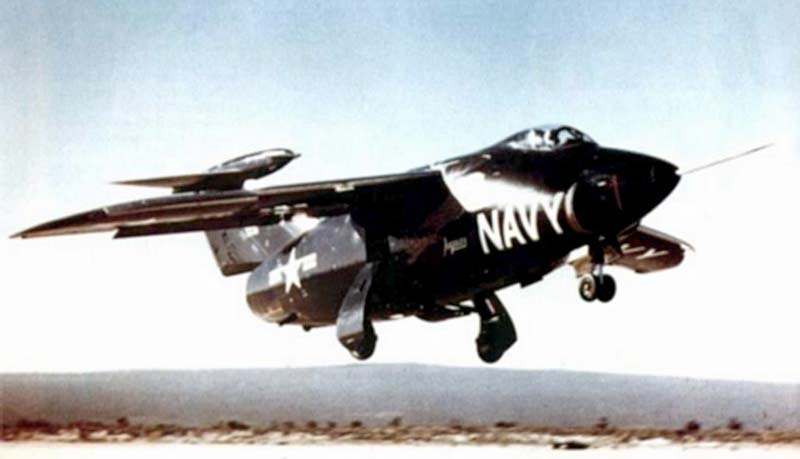The XF10F Jaguar is an experimental swing-wing carrier-based fighter, pioneering variable-geometry in aviation.
In brief
The Grumman XF10F Jaguar was an experimental naval fighter designed in the early 1950s, notable for being the first aircraft to incorporate variable geometry wings or “swing wings.” Although only one prototype was built and the program was short-lived, the Jaguar’s innovative design aimed to combine the takeoff and low-speed advantages of straight wings with the high-speed efficiency of swept wings. Despite never reaching operational status, its development marked a significant step in aviation technology, influencing future designs in variable-geometry wing aircraft and contributing to the evolution of fighter jet capabilities.
In an era marked by rapid advancements in aviation technology and increasing demands of carrier-based aircraft, the Grumman XF10F Jaguar represented an ambitious attempt to revolutionize fighter design through the implementation of variable geometry wings.
History of the Development of the Grumman XF10F Jaguar
Post-World War II, the U.S. Navy faced the challenge of improving the performance of carrier-based aircraft without compromising their operational versatility. The increasing speed of jet aircraft necessitated better high-speed performance while still maintaining low-speed stability for carrier landings. In response, Grumman began development of the XF10F Jaguar in the late 1940s as part of this quest for a superior naval fighter.
Launched by Grumman Aerospace, the program aimed to create the first fighter with variable geometry wings, allowing the aircraft to change its wing configuration mid-flight. This design was intended to provide the optimal wing shape for different flight conditions, significantly enhancing the aircraft’s performance envelope. The Jaguar first flew on 19 April 1952, showcasing the potential of this innovative technology. While the XF10F did not receive a specific NATO nickname, its development was a crucial technological endeavor of the time, reflecting the era’s innovative spirit and the Navy’s evolving needs.
Design of the Grumman XF10F Jaguar
The XF10F Jaguar’s most notable feature was its variable-sweep wing, which could pivot at the root from a straight position for takeoffs and landings to a swept-back position for high-speed flight. The aircraft was equipped with a Westinghouse J40 engine, initially intended to provide sufficient power for its ambitious performance goals.
The design brought several theoretical advantages, including improved takeoff and landing performance, higher top speeds, and enhanced overall maneuverability. However, the Jaguar also faced significant drawbacks, primarily related to the complexity and reliability of the swing-wing mechanism and the insufficient power of the available engines. These issues, combined with developmental delays and shifting priorities, ultimately limited the potential of the XF10F.

Performance of the Grumman XF10F Jaguar
As an experimental aircraft, the XF10F Jaguar’s performance was not fully realized due to the program’s cancellation before extensive testing could occur. The aircraft was intended to have significantly improved performance metrics across various flight conditions, leveraging the variable geometry wings. However, issues with the Westinghouse J40 engine and the complex wing mechanism hindered its development, preventing the Jaguar from reaching its full potential and leading to the program’s eventual termination.
Variants of the Grumman XF10F Jaguar
The XF10F Jaguar program centered around the single prototype constructed. As an experimental platform, it did not progress to the point of having distinct operational variants or production models. The focus remained on proving the concept of variable geometry wings and assessing its viability for future aircraft designs.
Military Use and Combat of the Grumman XF10F Jaguar
The Grumman XF10F Jaguar never saw combat or entered military service. Its role was strictly as a technology demonstrator, aiming to explore and resolve the challenges associated with variable geometry wings. While the Jaguar itself did not advance beyond the experimental stage, the insights gained from its development influenced future aircraft designs, including successful swing-wing aircraft like the F-111 Aardvark and the F-14 Tomcat.
The Grumman XF10F Jaguar stands as a significant, albeit brief, chapter in aviation history. As the first aircraft designed with variable geometry wings, it marked an ambitious attempt to expand the capabilities of fighter jets, particularly for carrier operations. Though the program faced insurmountable challenges and was eventually canceled, the Jaguar’s legacy influenced future generations of aircraft, contributing to the evolution of variable-sweep wing technology in military aviation. Its development during a time of rapid technological progress underscores the relentless pursuit of innovation and performance in the quest for air superiority.
Back to the experimental aircraft section.